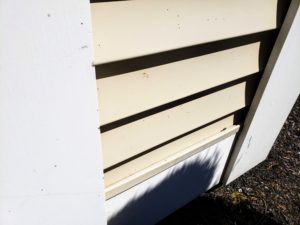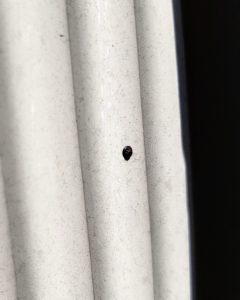ARTILLERY FUNGUS CAN STAIN HOMES AND CARS
By Chris Williams on May 2, 2019.
We sometimes get calls in spring from folks who claim that some kind of bug is leaving hundreds of black fecal spots or tiny eggs or something strange on the siding of their house. We’re usually able to rule out insects pretty quickly. While there are other possible causes, at this time of year, black specks on outdoor surfaces are often from Sphaerobolus fungi. The specks are sticky spores that have been ejected from tiny cup-shaped mushrooms that are living on decaying wood.

Artillery fungus on siding over mulch. Z. Ciras
The brownish black spots sort of look like fly specks, if you’re old enough to remember what accumulated house fly droppings looked like on walls of barns or surfaces. They sort of look like spider droppings that you find on surfaces underneath webs, except spider poop is white as well and not so randomly placed. On plant surfaces, the specks can be mistaken for scale insects, insect feces, or insect eggs.
Sphaerobolus stellatusis one of three species of the fungus in the U.S. Sphaerobolus means “sphere thrower, “ one common name for the fungus, and stellatus refers to the star-shaped fruiting structure that houses and ejects the spores. This fungus is usually referred to as artillery fungus or cannonball fungus because of the fact that it shoots its ripe spores up to 14 feet high and 18 feet straight out. It’s attracted by light and so actually aims for nearby white or bright surfaces.
DECAYING SHREDDED HARDWOOD MULCH IS USUALLY THE SOURCE
The reason that these spores so often end up on siding, windows, cars, decks, and other light-colored surfaces around homes is because the fungus commonly grows and feeds on shredded hardwood mulch that has accumulated and aged around the foundation. Infected mulch may have a bleached-out appearance. Besides wood mulch, the fungus can also grow in other sites such as decaying downed trees, rotting garden benches, soil with a wood component, and animal dung.
The fungus likes moisture and sends out its fruiting bodies in spring and fall when temperatures are within the range of 50-68°F. It’s not a summertime event since fruiting bodies are not produced above 77°F. The cup-shaped fruiting body is barely visible (1-3 mm in diameter) and easily overlooked in mulch unless you are searching for it. In its center is a mass of maturing spores that are catapulted into the air when conditions are right.
REMOVING THE FUNGAL SPORES IS PRACTICALLY IMPOSSIBLE

Close up of Artillery Fungus on white trim. Z. Ciras
The spores start out brown and change to black spots. If you try to clean or scrape a spot off, you will likely leave a brown stain behind. Power washing doesn’t work well once the spores have been in place for a while. Bottom line: artillery fungus spores are almost impossible to remove. You’re more likely to damage surfaces. Some experts say if the appearance of the spores bothers you, paint or replace instead.
Prevention of the fungus in the first place should be your goal. If you’ve already experienced the “spore splash,” it may be difficult to get rid of Sphaeroboluscompletely since the spores can remain viable for ten years. Few of us actually remove and replace our foundation mulch each season. Newly-placed mulch is less of a problem than old mulch already in place.
If you can, remove mulch already in place, even if it’s not shredded hardwood. If you can’t remove the mulch, at least rake it and spread it out so that it can dry out. Adding a layer of fresh mulch on top will help. In future, if you must use mulch, choose a synthetic (nonwood) mulch, or use a wood mulch that is more resistant to artillery fungus (pine bark mulch, wood chips, or cedar, redwood, or cypress mulch).
SPORES CAN SHOW UP INSIDE IN UNUSUAL CIRCUMSTANCES
In an interesting aside, these spores can show up on surfaces inside, too. This happens most often in connection with indoor plants that are potted in a soil mix with a large wood content, or when pots that are brought in from outside are topped off with mulch to retain moisture. Indoor plantscapes in malls, hotel lobbies, and other sites should consider the type of mulch used in their planted beds to avoid bombarding customers with fungal spores!